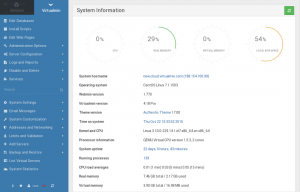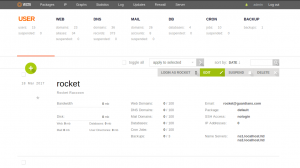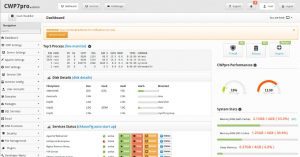Open-Source cPanel Alternatives
Tuesday September 24, 2019
Typically, managing servers and websites require a fair bit of knowledge, plus a good familiarity with the command line. For some, this can be a bit daunting – and that’s where control panels come in. A control panel collects most of the functions and tools needed to manage a server in one interface and presents it in a way that doesn’t require one to be especially technically adept. Once installed, most server functions can be handled in this one GUI, with no knowledge of the command line needed. A good control panel makes managing a server accessible to anyone.
If you already use a control panel, chances are it is cPanel, one of the most widely-used web hosting panels, especially in the US market. With recent changes to cPanel’s pricing structure that have sent prices for some of their users through the roof, you may be searching for alternatives. The good news is, there are plenty and most of them are free and open source. In this post, I’ll be doing an overview of some of the best free cPanel alternatives I’ve come across.
Virtualmin
 This first one is my personal favorite due to its extensive OS support and rich feature list. Virtualmin runs on almost any Linux or BSD based operating system with wide support for CentOS, Debian, and Ubuntu. By building upon Webmin, a solid control panel in its own right, Virtualmin boasts a wealth of features and makes it easy to host your websites, email and DNS. While Webmin is more about overall server management, such as editing configurations for your database server, web server, and mail server, Virtualmin adds features enabling it to directly manage your sites and databases. You can create new virtual hosts, manage databases, add or edit hosting packages, manage email accounts, view website statistics, install scripts and much more. Virtualmin is by far the most comprehensive free control panel that I’ve come across. Virtualmin also provides a professional version of their panel that includes support. Otherwise, they maintain active community forums where users help each other with support issues.
This first one is my personal favorite due to its extensive OS support and rich feature list. Virtualmin runs on almost any Linux or BSD based operating system with wide support for CentOS, Debian, and Ubuntu. By building upon Webmin, a solid control panel in its own right, Virtualmin boasts a wealth of features and makes it easy to host your websites, email and DNS. While Webmin is more about overall server management, such as editing configurations for your database server, web server, and mail server, Virtualmin adds features enabling it to directly manage your sites and databases. You can create new virtual hosts, manage databases, add or edit hosting packages, manage email accounts, view website statistics, install scripts and much more. Virtualmin is by far the most comprehensive free control panel that I’ve come across. Virtualmin also provides a professional version of their panel that includes support. Otherwise, they maintain active community forums where users help each other with support issues.
VestaCP
 VestaCP is another free and open-source control panel that I’m a fan of. Like Virtualmin, VestaCP is fully supported and runs on CentOS, Debian, and Ubuntu, but it is much easier to set up and manage. VestaCP handles all the basics with ease, allowing you to create virtual hosts for your sites, email accounts, and manage DNS – just as you would with most other control panels. It’s also much more pleasant to look at with its clean interface and much less clutter than Virtualmin’s GUI. While VestaCP is great due to its ease of use and clean aesthetic, it doesn’t give you the wide range of functionality that Virtualmin provides. I believe VestaCP is best for new users, especially those that want something simple and easy to use. Unfortunately, VestaCP has been plagued with a number of critical vulnerabilities that have been trivial to exploit. VestaCP offers support but it’s quite expensive in relation to the sparse feature set.
VestaCP is another free and open-source control panel that I’m a fan of. Like Virtualmin, VestaCP is fully supported and runs on CentOS, Debian, and Ubuntu, but it is much easier to set up and manage. VestaCP handles all the basics with ease, allowing you to create virtual hosts for your sites, email accounts, and manage DNS – just as you would with most other control panels. It’s also much more pleasant to look at with its clean interface and much less clutter than Virtualmin’s GUI. While VestaCP is great due to its ease of use and clean aesthetic, it doesn’t give you the wide range of functionality that Virtualmin provides. I believe VestaCP is best for new users, especially those that want something simple and easy to use. Unfortunately, VestaCP has been plagued with a number of critical vulnerabilities that have been trivial to exploit. VestaCP offers support but it’s quite expensive in relation to the sparse feature set.
HestiaCP
 HestiaCP is a newer control panel that’s a fork of VestaCP code. Like VestaCP, it is free and open-source, although HestiaCP now maintains their own code and no longer merges code directly from VestaCP. It’s completely independent and more actively developed than VestaCP, which has lead to it gaining popularity among previous VestaCP users. While a lot of the code is identical to VestaCP, I believe they’ve made significant improvements to the UI. VestaCP is quite bland and lacking in detail, whereas HestiaCP looks polished and professional while adding the detail missing from its predecessor. The downside of using HestiaCP is that it has a significantly smaller community behind it, although it seems the developers are very helpful and responsive. I couldn’t find out if HestiaCP offers paid support, which would be a nice option to have, especially if you’re looking to run this in an enterprise environment.
HestiaCP is a newer control panel that’s a fork of VestaCP code. Like VestaCP, it is free and open-source, although HestiaCP now maintains their own code and no longer merges code directly from VestaCP. It’s completely independent and more actively developed than VestaCP, which has lead to it gaining popularity among previous VestaCP users. While a lot of the code is identical to VestaCP, I believe they’ve made significant improvements to the UI. VestaCP is quite bland and lacking in detail, whereas HestiaCP looks polished and professional while adding the detail missing from its predecessor. The downside of using HestiaCP is that it has a significantly smaller community behind it, although it seems the developers are very helpful and responsive. I couldn’t find out if HestiaCP offers paid support, which would be a nice option to have, especially if you’re looking to run this in an enterprise environment.
CentOS Web Panel
 CentOS Web Panel is a fully-fledged control panel with many great features. As the name suggests, it’s CentOS based which is a favorite OS among people looking for stability and long-term support. CentOS Web Panel provides the same fine granular control over your server as Virtualmin while touting some additional interesting features. The AutoFixer feature, for example, is designed to detect and fix configuration issues with your server. On the down-side, the web interface for CentOS Web Panel, unfortunately, doesn’t look as nice as the others reviewed here and it isn’t as popular as Virtualmin or VestaCP. This leads to a smaller community, though it does provide support as a service. It also looks like CentOS Web Panel hasn’t released an update since 2018, which suggests that the project is no longer actively being developed you may want to proceed with caution.
CentOS Web Panel is a fully-fledged control panel with many great features. As the name suggests, it’s CentOS based which is a favorite OS among people looking for stability and long-term support. CentOS Web Panel provides the same fine granular control over your server as Virtualmin while touting some additional interesting features. The AutoFixer feature, for example, is designed to detect and fix configuration issues with your server. On the down-side, the web interface for CentOS Web Panel, unfortunately, doesn’t look as nice as the others reviewed here and it isn’t as popular as Virtualmin or VestaCP. This leads to a smaller community, though it does provide support as a service. It also looks like CentOS Web Panel hasn’t released an update since 2018, which suggests that the project is no longer actively being developed you may want to proceed with caution.
As you can see, there are a number of alternative control panels out there, freely available for use. While most of them are not as comprehensive as cPanel, they are never-the-less quite decent and robust enough to be deemed production-ready by many. Hopefully, this brief overview will help navigate some of the better open-source alternatives to cPanel.
If you already use a control panel, chances are it is cPanel, one of the most widely-used web hosting panels, especially in the US market. With recent changes to cPanel’s pricing structure that have sent prices for some of their users through the roof, you may be searching for alternatives. The good news is, there are plenty and most of them are free and open source. In this post, I’ll be doing an overview of some of the best free cPanel alternatives I’ve come across.
Virtualmin
 This first one is my personal favorite due to its extensive OS support and rich feature list. Virtualmin runs on almost any Linux or BSD based operating system with wide support for CentOS, Debian, and Ubuntu. By building upon Webmin, a solid control panel in its own right, Virtualmin boasts a wealth of features and makes it easy to host your websites, email and DNS. While Webmin is more about overall server management, such as editing configurations for your database server, web server, and mail server, Virtualmin adds features enabling it to directly manage your sites and databases. You can create new virtual hosts, manage databases, add or edit hosting packages, manage email accounts, view website statistics, install scripts and much more. Virtualmin is by far the most comprehensive free control panel that I’ve come across. Virtualmin also provides a professional version of their panel that includes support. Otherwise, they maintain active community forums where users help each other with support issues.
This first one is my personal favorite due to its extensive OS support and rich feature list. Virtualmin runs on almost any Linux or BSD based operating system with wide support for CentOS, Debian, and Ubuntu. By building upon Webmin, a solid control panel in its own right, Virtualmin boasts a wealth of features and makes it easy to host your websites, email and DNS. While Webmin is more about overall server management, such as editing configurations for your database server, web server, and mail server, Virtualmin adds features enabling it to directly manage your sites and databases. You can create new virtual hosts, manage databases, add or edit hosting packages, manage email accounts, view website statistics, install scripts and much more. Virtualmin is by far the most comprehensive free control panel that I’ve come across. Virtualmin also provides a professional version of their panel that includes support. Otherwise, they maintain active community forums where users help each other with support issues.VestaCP
 VestaCP is another free and open-source control panel that I’m a fan of. Like Virtualmin, VestaCP is fully supported and runs on CentOS, Debian, and Ubuntu, but it is much easier to set up and manage. VestaCP handles all the basics with ease, allowing you to create virtual hosts for your sites, email accounts, and manage DNS – just as you would with most other control panels. It’s also much more pleasant to look at with its clean interface and much less clutter than Virtualmin’s GUI. While VestaCP is great due to its ease of use and clean aesthetic, it doesn’t give you the wide range of functionality that Virtualmin provides. I believe VestaCP is best for new users, especially those that want something simple and easy to use. Unfortunately, VestaCP has been plagued with a number of critical vulnerabilities that have been trivial to exploit. VestaCP offers support but it’s quite expensive in relation to the sparse feature set.
VestaCP is another free and open-source control panel that I’m a fan of. Like Virtualmin, VestaCP is fully supported and runs on CentOS, Debian, and Ubuntu, but it is much easier to set up and manage. VestaCP handles all the basics with ease, allowing you to create virtual hosts for your sites, email accounts, and manage DNS – just as you would with most other control panels. It’s also much more pleasant to look at with its clean interface and much less clutter than Virtualmin’s GUI. While VestaCP is great due to its ease of use and clean aesthetic, it doesn’t give you the wide range of functionality that Virtualmin provides. I believe VestaCP is best for new users, especially those that want something simple and easy to use. Unfortunately, VestaCP has been plagued with a number of critical vulnerabilities that have been trivial to exploit. VestaCP offers support but it’s quite expensive in relation to the sparse feature set.HestiaCP
 HestiaCP is a newer control panel that’s a fork of VestaCP code. Like VestaCP, it is free and open-source, although HestiaCP now maintains their own code and no longer merges code directly from VestaCP. It’s completely independent and more actively developed than VestaCP, which has lead to it gaining popularity among previous VestaCP users. While a lot of the code is identical to VestaCP, I believe they’ve made significant improvements to the UI. VestaCP is quite bland and lacking in detail, whereas HestiaCP looks polished and professional while adding the detail missing from its predecessor. The downside of using HestiaCP is that it has a significantly smaller community behind it, although it seems the developers are very helpful and responsive. I couldn’t find out if HestiaCP offers paid support, which would be a nice option to have, especially if you’re looking to run this in an enterprise environment.
HestiaCP is a newer control panel that’s a fork of VestaCP code. Like VestaCP, it is free and open-source, although HestiaCP now maintains their own code and no longer merges code directly from VestaCP. It’s completely independent and more actively developed than VestaCP, which has lead to it gaining popularity among previous VestaCP users. While a lot of the code is identical to VestaCP, I believe they’ve made significant improvements to the UI. VestaCP is quite bland and lacking in detail, whereas HestiaCP looks polished and professional while adding the detail missing from its predecessor. The downside of using HestiaCP is that it has a significantly smaller community behind it, although it seems the developers are very helpful and responsive. I couldn’t find out if HestiaCP offers paid support, which would be a nice option to have, especially if you’re looking to run this in an enterprise environment.CentOS Web Panel
 CentOS Web Panel is a fully-fledged control panel with many great features. As the name suggests, it’s CentOS based which is a favorite OS among people looking for stability and long-term support. CentOS Web Panel provides the same fine granular control over your server as Virtualmin while touting some additional interesting features. The AutoFixer feature, for example, is designed to detect and fix configuration issues with your server. On the down-side, the web interface for CentOS Web Panel, unfortunately, doesn’t look as nice as the others reviewed here and it isn’t as popular as Virtualmin or VestaCP. This leads to a smaller community, though it does provide support as a service. It also looks like CentOS Web Panel hasn’t released an update since 2018, which suggests that the project is no longer actively being developed you may want to proceed with caution.
CentOS Web Panel is a fully-fledged control panel with many great features. As the name suggests, it’s CentOS based which is a favorite OS among people looking for stability and long-term support. CentOS Web Panel provides the same fine granular control over your server as Virtualmin while touting some additional interesting features. The AutoFixer feature, for example, is designed to detect and fix configuration issues with your server. On the down-side, the web interface for CentOS Web Panel, unfortunately, doesn’t look as nice as the others reviewed here and it isn’t as popular as Virtualmin or VestaCP. This leads to a smaller community, though it does provide support as a service. It also looks like CentOS Web Panel hasn’t released an update since 2018, which suggests that the project is no longer actively being developed you may want to proceed with caution.As you can see, there are a number of alternative control panels out there, freely available for use. While most of them are not as comprehensive as cPanel, they are never-the-less quite decent and robust enough to be deemed production-ready by many. Hopefully, this brief overview will help navigate some of the better open-source alternatives to cPanel.